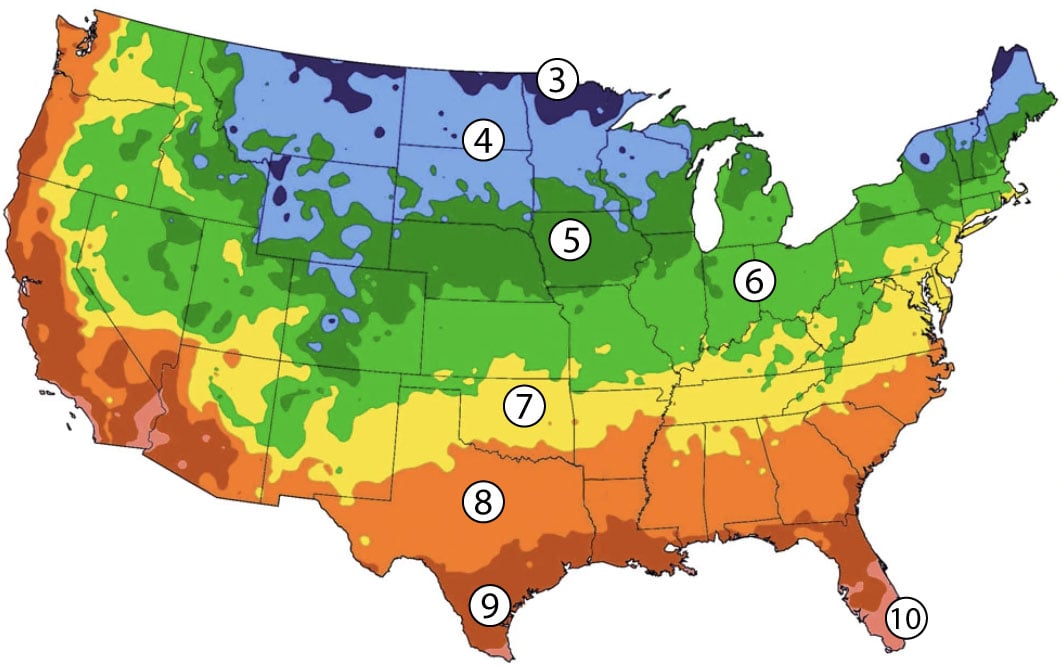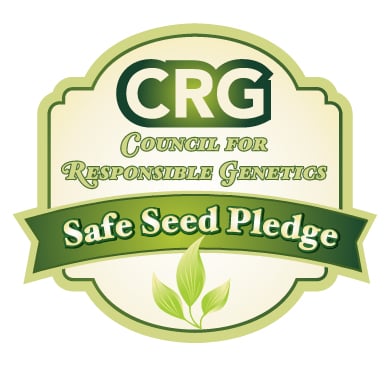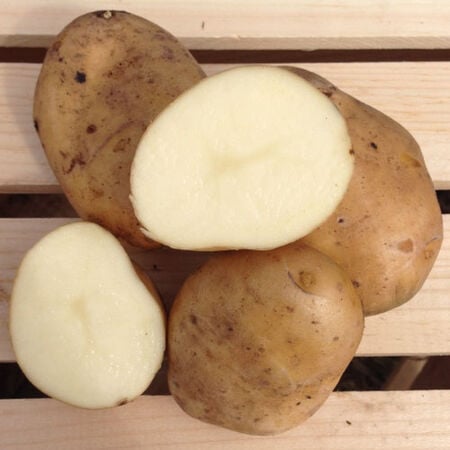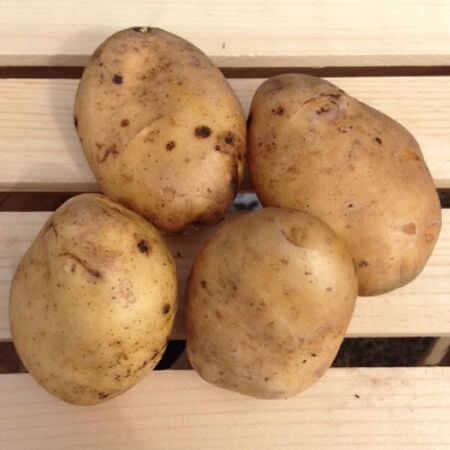Kennebec, Seed Potatoes
Key Attributes
Product Details
Weight
2Depth
3.25Height
5Width
3Plant Height
12-20"Botanical Name
Solanum tuberosumSeed Type
SeedAdditional Characteristics
Soup GardenSeeds Per Pound
3-7Row Spacing
12-18"Sow Depth
6-8"Disease Resistance
FLBBreed
Open-polliantedSun
Full SunMaturity
Main SeasonLife Cycle
AnnualSow Method
Direct SowPlant Spacing
8-12"Categories
PotatoGermination
22,23,24,14,15,16,17,18,19,20,21Days To Maturity (# Days)
80Heirloom
HeirloomSeeds Per Acre
1,600 lbsComponents
Growing Instructions
![]() Learning Download: How to Grow Seed Potatoes
Learning Download: How to Grow Seed Potatoes
Potatoes are an excellent carb source and culinary staple that can be added to roasts, stews or as an addition to a meal. They come in various colors and shapes, such as the traditional Yukon gold to purple fingerling potatoes.
Before Planting: A day or two before planting, use a sharp, clean knife to slice the larger seed potatoes into two seeds. Each seed should be at least 1 1/2-2inches in size, and must contain at least 1 “eye” or bud. Smaller potatoes may be planted whole. Over the next couple days the cut side of the potato will form a thick callous over the cuts, which will help to prevent it from rotting once planted.

Planting: Potatoes may be planted as soon as the ground can be worked in the early spring, but you must use good judgment. The soil should be evenly moist, but not wet or soggy. If the soil is water logged when you dig, not only will you risk “caking” the soil, your seed potatoes will probably rot before they even get started. Assume that you get on average 4 potato seeds per pound of potatoes. If you plant a seed potato, plant with the eye facing up in a trench dug 4 inches deep. For a 8 foot row, you will need 10 lbs; for a 25 foot row, 20 lbs; for a 50 foot row and for a 100 foot row, 40 lbs.
Watering: Water 1 to 2 inches per week.
Fertilizer: Potatoes crave nitrogen and phosphorous. Prior to planting, non-organic gardeners can use a standard 15-15-15 fertilizer and work it into the soil’s surface. To aid in potato growth, side dress freshly sprouted seeds with a mix of cottonseed meal, bone meal and green meal to increase the soil’s acidity. You can also add in kelp meal. During the growing season, feed the plants with fish emulsion or kelp extract every two weeks until the plants bloom. Then, six weeks after planting, side dress the potatoes with the same fertilizer mix used at planting but only half as much.
Days to Maturity: Potatoes are ready to harvest when the foliage begins to die back. (See each variety for days to maturity)
Harvesting: Cut the brown foliage off and leave the potatoes for 10 to 14 more days. Dig up the potatoes on a dry day but handle them gently as they bruise easily. Once harvested, store the potatoes in a cool, dark place for two weeks to allow for the skin to cure. Curing the skin allows for the potatoes to keep longer. Once cured, do not store potatoes near apples, as the apples make the potatoes go bad.
Tips: Once plants reach 6 inches tall but before they begin to flower, gardeners should start the hilling process. This helps prevent potato sunburn, which creates a chemical called solanine that turns the potato green. Solanine is toxic, so do not eat green potatoes. This process needs to be done every few weeks throughout the potato’s growing season.
Shipping Schedule
Spring seed potatoes will ship at the appropriate time for your planting zone. The chart below estimates when your seed potatoes will arrive. You will receive an email notifying you when your seed potatoes ship giving you a few days to prepare for planting.
This item’s size, weight, or shape may require an additional shipping surcharge based on the shipping location selected. Specific charges will be displayed during checkout. We are unable to take specific shipping dates at this time.
*This product is perishable and does not ship outside the United States.
|
 |
Our Seed Promise
 "Agriculture and seeds" provide the basis upon which our lives depend. We must protect this foundation as a safe and genetically stable source for future generations. For the benefit of all farmers, gardeners and consumers who want an alternative, we pledge that we do not knowingly buy or sell genetically engineered seeds or plants.
"Agriculture and seeds" provide the basis upon which our lives depend. We must protect this foundation as a safe and genetically stable source for future generations. For the benefit of all farmers, gardeners and consumers who want an alternative, we pledge that we do not knowingly buy or sell genetically engineered seeds or plants.
The mechanical transfer of genetic material outside of natural reproductive methods and between genera, families or kingdoms, poses great biological risks as well as economic, political, and cultural threats. We feel that genetically engineered varieties have been insufficiently tested prior to public release. More research and testing is necessary to further assess the potential risks of genetically engineered seeds. Further, we wish to support agricultural progress that leads to healthier soils, to genetically diverse agricultural ecosystems, and ultimately to healthy people and communities.
To learn more about the "Safe Seed Pledge" please visit www.councilforresponsiblegenetics.org.
Key Attributes
Product Details
Weight
2Depth
3.25Height
5Width
3Plant Height
12-20"Botanical Name
Solanum tuberosumSeed Type
SeedAdditional Characteristics
Soup GardenSeeds Per Pound
3-7Row Spacing
12-18"Sow Depth
6-8"Disease Resistance
FLBBreed
Open-polliantedSun
Full SunMaturity
Main SeasonLife Cycle
AnnualSow Method
Direct SowPlant Spacing
8-12"Categories
PotatoGermination
22,23,24,14,15,16,17,18,19,20,21Days To Maturity (# Days)
80Heirloom
HeirloomSeeds Per Acre
1,600 lbsComponents
Growing Instructions
![]() Learning Download: How to Grow Seed Potatoes
Learning Download: How to Grow Seed Potatoes
Potatoes are an excellent carb source and culinary staple that can be added to roasts, stews or as an addition to a meal. They come in various colors and shapes, such as the traditional Yukon gold to purple fingerling potatoes.
Before Planting: A day or two before planting, use a sharp, clean knife to slice the larger seed potatoes into two seeds. Each seed should be at least 1 1/2-2inches in size, and must contain at least 1 “eye” or bud. Smaller potatoes may be planted whole. Over the next couple days the cut side of the potato will form a thick callous over the cuts, which will help to prevent it from rotting once planted.

Planting: Potatoes may be planted as soon as the ground can be worked in the early spring, but you must use good judgment. The soil should be evenly moist, but not wet or soggy. If the soil is water logged when you dig, not only will you risk “caking” the soil, your seed potatoes will probably rot before they even get started. Assume that you get on average 4 potato seeds per pound of potatoes. If you plant a seed potato, plant with the eye facing up in a trench dug 4 inches deep. For a 8 foot row, you will need 10 lbs; for a 25 foot row, 20 lbs; for a 50 foot row and for a 100 foot row, 40 lbs.
Watering: Water 1 to 2 inches per week.
Fertilizer: Potatoes crave nitrogen and phosphorous. Prior to planting, non-organic gardeners can use a standard 15-15-15 fertilizer and work it into the soil’s surface. To aid in potato growth, side dress freshly sprouted seeds with a mix of cottonseed meal, bone meal and green meal to increase the soil’s acidity. You can also add in kelp meal. During the growing season, feed the plants with fish emulsion or kelp extract every two weeks until the plants bloom. Then, six weeks after planting, side dress the potatoes with the same fertilizer mix used at planting but only half as much.
Days to Maturity: Potatoes are ready to harvest when the foliage begins to die back. (See each variety for days to maturity)
Harvesting: Cut the brown foliage off and leave the potatoes for 10 to 14 more days. Dig up the potatoes on a dry day but handle them gently as they bruise easily. Once harvested, store the potatoes in a cool, dark place for two weeks to allow for the skin to cure. Curing the skin allows for the potatoes to keep longer. Once cured, do not store potatoes near apples, as the apples make the potatoes go bad.
Tips: Once plants reach 6 inches tall but before they begin to flower, gardeners should start the hilling process. This helps prevent potato sunburn, which creates a chemical called solanine that turns the potato green. Solanine is toxic, so do not eat green potatoes. This process needs to be done every few weeks throughout the potato’s growing season.
Shipping Schedule
Spring seed potatoes will ship at the appropriate time for your planting zone. The chart below estimates when your seed potatoes will arrive. You will receive an email notifying you when your seed potatoes ship giving you a few days to prepare for planting.
This item’s size, weight, or shape may require an additional shipping surcharge based on the shipping location selected. Specific charges will be displayed during checkout. We are unable to take specific shipping dates at this time.
*This product is perishable and does not ship outside the United States.
|
 |
Our Seed Promise
 "Agriculture and seeds" provide the basis upon which our lives depend. We must protect this foundation as a safe and genetically stable source for future generations. For the benefit of all farmers, gardeners and consumers who want an alternative, we pledge that we do not knowingly buy or sell genetically engineered seeds or plants.
"Agriculture and seeds" provide the basis upon which our lives depend. We must protect this foundation as a safe and genetically stable source for future generations. For the benefit of all farmers, gardeners and consumers who want an alternative, we pledge that we do not knowingly buy or sell genetically engineered seeds or plants.
The mechanical transfer of genetic material outside of natural reproductive methods and between genera, families or kingdoms, poses great biological risks as well as economic, political, and cultural threats. We feel that genetically engineered varieties have been insufficiently tested prior to public release. More research and testing is necessary to further assess the potential risks of genetically engineered seeds. Further, we wish to support agricultural progress that leads to healthier soils, to genetically diverse agricultural ecosystems, and ultimately to healthy people and communities.
To learn more about the "Safe Seed Pledge" please visit www.councilforresponsiblegenetics.org.




